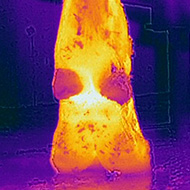
Researchers compare high and low-cost thermal imaging devices.
Low-cost thermal imaging devices show minimal difference in effectiveness of detecting lameness in dairy cattle when compared to more expensive devices, according to a new study.
Researchers at the Royal Veterinary College (RVC) compared the thermal images of 83 cows’ hind feet, captured with both high and low cost thermal imaging devices. The team found very little difference in the performance and quality of the devices despite the low-cost device being two per cent the cost of the high cost device.
Interestingly, images captured suggested that low-cost thermal imaging devices would be the most cost-effective choice to help detect lameness.
Lead researcher Aidan Coe, an undergraduate veterinary student at the RVC, said: “There is a possibility that low-cost infrared thermal imaging devices could be used as an objective, cost-effective method of assessing the lameness of the national herd, which may prove a useful adjunct to the current lameness detection methods.”
With 20–25 per cent of all cattle in the UK suffering from lameness, the sector experiences a yearly loss of £53.5 million. Therefore, by lowering the high economic expenses of the condition and improving calf wellbeing, the study's results might have a wide range of positive effects on farmers and the dairy sector.
Project supervisor Dr Nicola Blackie, a senior lecturer in production animal science at the RVC, said: “At the RVC we are proud to be able to support the research of all of our students no matter the stage of study they are at. It is the work and dedication of researchers like Aidan that lead to significant progress within the veterinary and farming industries.
“This project has the potential to make early detection of lameness in cattle accessible to more of the farming population, with great economic and welfare benefits. By demonstrating the almost equal effectiveness of lower-cost thermal imaging devices to that of more expensive equivalents, this study helps make this technology available to much more of the farming population.”
The study, Comparison of Low- and High-Cost Infrared Thermal Imaging Devices for the Detection of Lameness in Dairy Cattle, is published in Veterinary Sciences.
Image (C) RVC.



 FIVP has shared a survey, inviting those working in independent practice to share their views on the CMA's proposed remedies.
FIVP has shared a survey, inviting those working in independent practice to share their views on the CMA's proposed remedies.